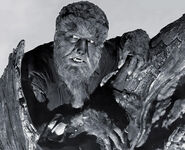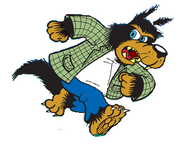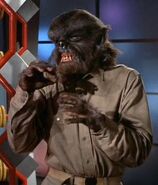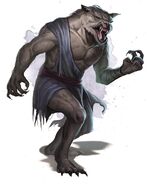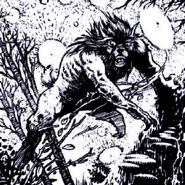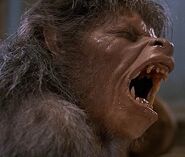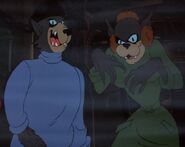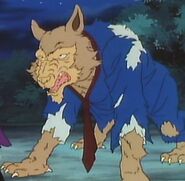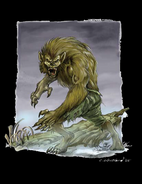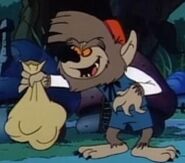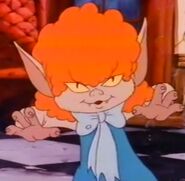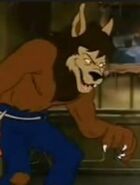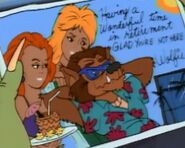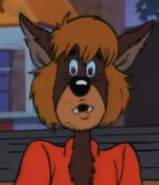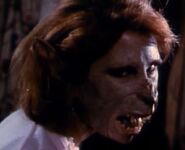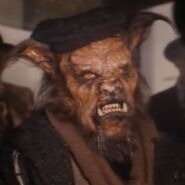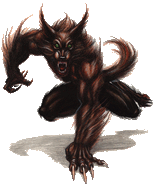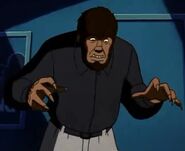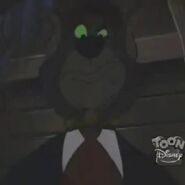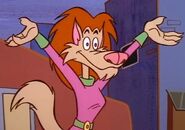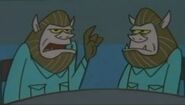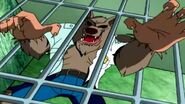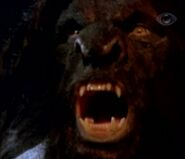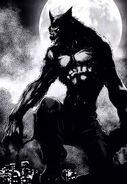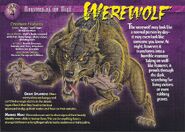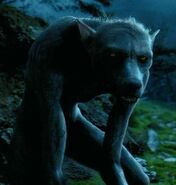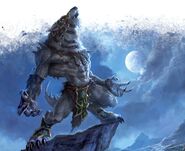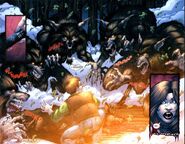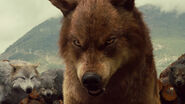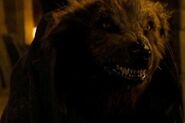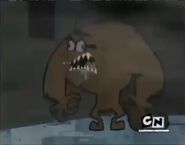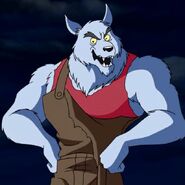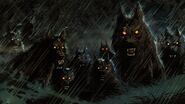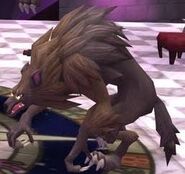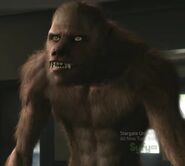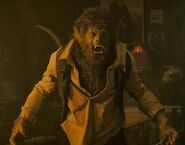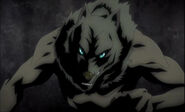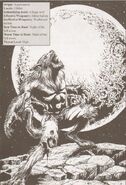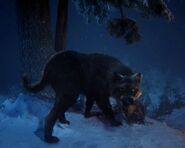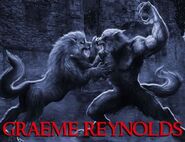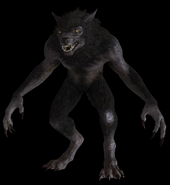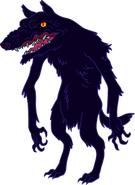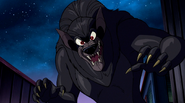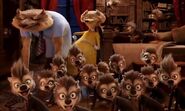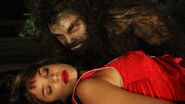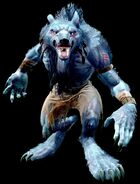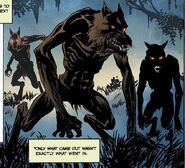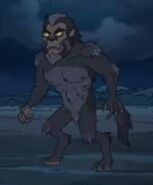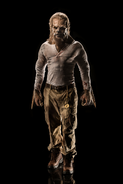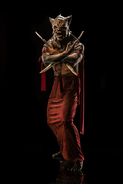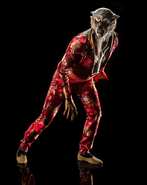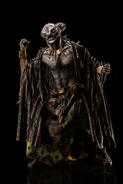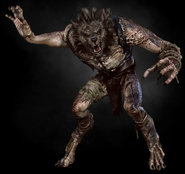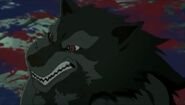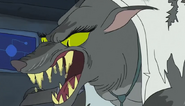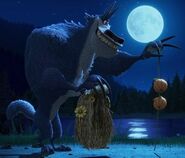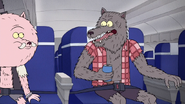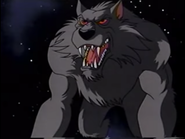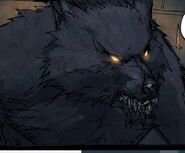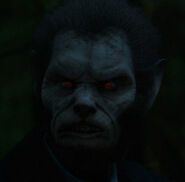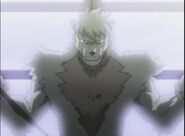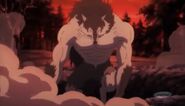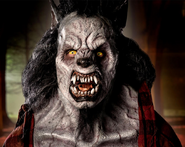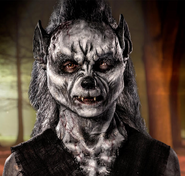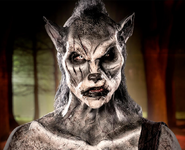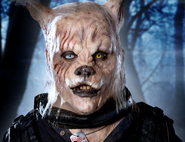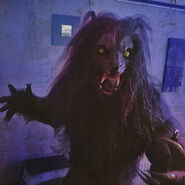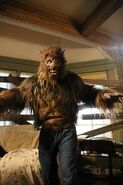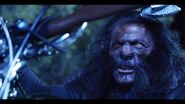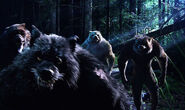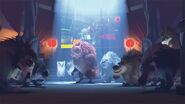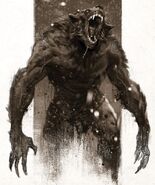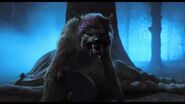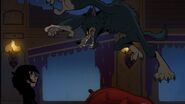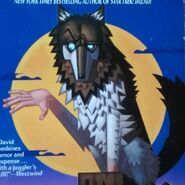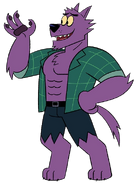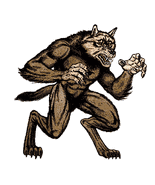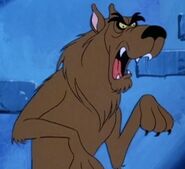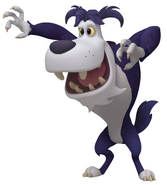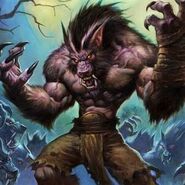| Lycanthrope | |||
|---|---|---|---|
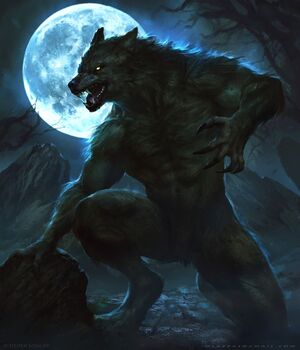
| |||
| Naming | |||
| Others | Werewolf (masculine or gender neutral) Were-wolf Wolf Man Wifwolf (feminine, seldom used) | ||
| Morphology | |||
| Body type | Canine-humanoid | ||
| Average height | Varies | ||
| Average weight | Varies | ||
| Intelligence | |||
| Sentience | Sentient | ||
| Sapience | Varies | ||
| Aggressivity | Varies (typically Extreme) | ||
| Language | Howling Roaring Growling and Snarling Sometimes capable of talking, even when transformed | ||
| Ecology | |||
| Place of origin | Europe | ||
| Habitat | Anywhere | ||
| Diet | Carnivorous | ||
| Locomotion | Bipedal Sometimes quadruped when transformed | ||
| Lifespan | Human-like | ||
| Reproduction | Viviparous, or assimilation via biting | ||
| Related species | Human Werecat Vampire | ||
| Behind the Scenes | |||
| Universe | Real | ||
| Performed by | Various | ||
Lycanthropy is the condition in which a human being is periodically transformed into a vicious wolf or a human/wolf hybrid. A person affected by this condition is referred to as a Werewolf or Lycanthrope.
Historically, numerous people have been accused of being werewolves, with wide persecutions happening all over Europe, particularly during the Renaissance.
Etymologically, the term "Werewolf" should be exclusively used for males. The female equivalent would probably be "Wifwolf", which is seldom used.
Overview[]
In modern stories, the transformation into the Werewolf is involuntary, triggered when the subject finds himself or herself under the influence of the full moon. How much they retain (or fail to retain) their sapience and self-control after the transformation varies from tale to tale. They're also shown to be highly vulnerable to silver.
Like vampirism, lycanthropy is typically portrayed as a transmitted condition: the victims of Werewolf bites will become infected and start turning into Werewolves themselves. Conversely, it has also been portrayed as an inherited generic condition, or as the result of curses and other forms of dark magic.
Stories about werewolves have existed since ancient times and were already popular in the Greek and Roman civilizations. In literature, they have been popular since the Middle Ages, with Marie de France's "Bisclavret" constituting one of the earliest examples.
Association between Werewolves and Vampires was already recurring in Bram Stoker's prose, in which vampires can typically assume the form of a wolf, and exert command over both natural and supernatural wolves. As a result, many works have portrayed Werewolves as servants and associates of Vampires; with the bloody rivalry sometimes seen between the two races constituting a more modern trope.
Appearance[]
Their transformed forms may have varying levels of resemblance to wolves. They may either be completely wolf-like, or be humanoid with minor wolf characteristics, like fur and fangs, or they may simply resemble an anthropomorphic wolf, the last being the most common.
In popular culture[]
Werewolves are featured in The Lost World season 2 episode "The Visitor", in which they are feared by native tribes of the plateau. Lycanthropy is portrayed as highly virulent, as it can be transmitted even by the smallest scratches. The first symptoms of infection manifest in the form of a strong debilitating fever and painful convulsions, only for the subject to return to normal on the next day, but start showing animalistic and violent tendencies. Only under the moonlight does the physical transformation occur. According to a local shaman, werewolves can only be harmed by silver or fire. It has been shown that these werewolves live in dark places, sleep communally in caves and are mostly active at night, leading Prof. Challenger to speculate that they might be sensitive to light. They come back to normal during the day, and may also return to their human form when they die. At the end of the episode, Challenger manages to develop a cure by using a silver nitrate injection.
In the Scooby-Doo universe, it appears werewolves never shapeshift and cannot infect others. When Count Dracula wanted to create a werewolf to participate in his Monster Road Rally - as the previous one had retired - he resorted to an old prophecy that pointed out Shaggy Rogers as a candidate for lycanthropy. According to this prophecy, every 500 years the moon comes in the perfect position to transform a selected human (Shaggy in this case) into a werewolf if he's exposed to it at the right time. For a brief period after being exposed to the moonlight, Shaggy kept transforming back and forth every time he hiccuped. However, once his transformation was stabilized, he remained in his werewolf form permanently, and could only become human again by reading a magic spell from the book. Similarly, lycanthropes such as Winnie Werewolf and Woof Woof appear to have no human form whatsoever. Conversely, an episode of The Richie Rich/Scooby-Doo Show did feature a medallion that would turn the wearer into a werewolf only as long as the moon shined upon them. The werewolf from The New Scooby-Doo Mysteries episode "A Halloween Hassle at Dracula's Castle" followed the classic variety of a human being spontaneously transformed by the full moon. The first episode of The 13 Ghosts of Scooby-Doo features an entire village of lycanthropes in the Himalayas which shift to human form during the day. In their case, however, it was the result of a curse sent by spirits after the villagers captured and imprisoned the world's 13 most dangerous ghosts. Still, when Daphne Blake drinks a beverage containing wolf-bane, she too turns into a lycanthrope along with the rest of the townsfolk. Fortunately, Flim-Flam's Lotsa Luck Joy Juice provides a permanent cure.
In Hotel Transylvania too the lycanthropes appear to have no human form. This is consistent with some folkloric werewolves, such as the Scottish Wulver, which likewise never shapeshifts and has never been human. It should be noted that a werewolf who doesn't shapeshift is not very much distinct from other mythological canine humanoids such as the Beast of Bray Road and the classical Cynocephali.
In Dungeons & Dragons, the word "lycanthrope" is erroneously used to refer to all were-creatures.
Works featuring Lycanthropes[]
Literature[]
- Bisclavret, by Marie de France (1175)
- The White Wolf of the Hartz Mountains, by Frederick Marryat (1839)
- The Wolf Leader, by Alexandre Dumas (1857)
- "The Ghost-Eater", by C. M. Eddy, Jr. and H. P. Lovecraft (1924)
- The Circus of Dr. Lao, by Charles G. Finney (1935)
- "Monsters in the Night", by Clark Ashton Smith (1954)
- The Silmarillion, by J. R. R. Tolkien (1977)
- Cycle of the Werewolf, by Stephen King (1983)
- High Moor, by Graeme Reynolds (2011)
- High Moor 2: Moonstruck, by Graeme Reynolds (2013)
- High Moor 3: Blood Moon, by Graeme Reynolds (2015)
- Howling Mad, by Peter David (1989)
- The Howling, by Gary Brandner (1977)
- The Howling II, by Gary Brandner (1979)
- The Howling III, by Gary Brandner (1985)
- The Bloody Red Baron, by Kim Newman (1995) (Mentioned only)
Comics[]
- Alabaster: Wolves
- The Astounding Wolf-Man
- Broken Moon
- Broken Moon: Legends of the Deep
- Bug-a-Booo
- Creepy
- Dark Shadows
- Dead of Night featuring Werewolf By Night
- Don Dracula
- Dragon Ball
- Giant-Size Werewolf
- Hellboy
- House of Mystery
- The Howling: Revenge of the Werewolf Queen
- Jughead: The Hunger
- Lethal Instinct
- Moonshine
- R.R.H
- Rosario + Vampire
- Savage (2008)
- Werewolf by Night
- Werewolf: The Apocalypse
- Wolf Moon
- World War Wolves
Films[]
- Abbott and Costello Meet Frankenstein
- Alvin and the Chipmunks Meet the Wolfman
- An American Werewolf in London
- An American Werewolf in Paris
- Among the Shadows
- The Ancines Woods
- Another WolfCop
- Bad Moon
- Battledogs
- The Beast Must Die
- Beast of the Yellow Night
- Big Bad Wolf
- Big Fish
- Blood & Chocolate
- Boogeyman Pop
- The Cabin in the Woods
- Cast a Deadly Spell
- The Company of Wolves
- Cross of the Seven Jewels
- The Curse of the Werewolf
- Cry of the Werewolf
- The Daughter of Dr. Jekyll
- Dark Moon Rising
- Despicable Me
- Dog Soldiers
- The Feeding
- Female Werewolf
- Frankenstein Meets the Wolf Man
- Freaks of Nature
- Full Moon High
- The Fury of the Wolfman
- Harry Potter and the Prisoner of Azkaban
- Hotel Transylvania trilogy
- House of Dracula
- House of Frankenstein
- Legend of the Werewolf
- Mad Mad Mad Monsters
- Mad Monster Party?
- Monster Dog
- Monster Family
- The Monster Squad
- Moon of the Wolf
- Nature of the Beast
- The Nightmare Before Christmas
- Nosferatu
- Open Season: Scared Silly
- The Return of the Vampire
- Scooby-Doo and the Ghoul School
- Scooby-Doo! and the Goblin King
- Scooby-Doo and the Reluctant Werewolf
- Teen Wolf
- Twilight film series
- Underworld: Rise of the Lycans
- Van Helsing
- War Wolves
- Werewolf of London
- The Werewolf of Washington
- The Werewolf of Woodstock
- Werewolf in a Girls' Dormitory
- Werewolf Rising
- Werewolf Woman
- Werewolves on Wheels
- Wolf Blood
- WolfCop
- The Wolf Man
- The Wolfman
Television[]
- The 13 Ghosts of Scooby-Doo
- Archie's Weird Mysteries
- Being Human
- Bitten
- Buffy the Vampire Slayer
- Cloudy With A Chance Of Meatballs
- Dark Shadows
- Face Off
- Fangface
- Freakazoid!
- The Grim Adventures of Billy and Mandy
- Grimm (as a disease affecting Blutbaden)
- Johnny Bravo
- Kolchak: The Night Stalker
- Lost Tapes
- The Lost World
- Monsters
- The Munsters
- The New Scooby-Doo Mysteries
- Night Gallery
- Once Upon a Time
- Penny Dreadful
- Quack Pack
- The Real Ghostbusters
- Regular Show
- The Richie Rich/Scooby-Doo Show
- Sanctuary
- She-Wolf of London
- The Simpsons
- The Smurfs
- Supernatural
- Tales from the Crypt
- Tales from the Darkside
- Teen Wolf
- True Blood
- The Vampire Diaries
- Vampirina
- Voyage to the Bottom of the Sea
- The Order (2019)
- Wednesday Addams (2022)
Video games[]
- The Elder Scrolls
- Killer Instinct
- Skylanders
- The Witcher
Gallery[]
"Reverse Lycanthropes"[]
The following are examples of "reverse lycanthropes": lupine creatures that become human under the influence of the full moon.
Non-human "Lycanthropes"[]
The following are examples of non-human species afflicted with lycanthropy.
Notes[]
- Besides lycanthropy, there exist several other forms of therianthropy, i.e., men turning into animal-hybrids of some sort. Different cultures over the world tell stories of things that could be referred to as "Were-Boars", "Were-Crocodiles", "Were-Tigers" and even "Were-Dolphins" (these names aren't used, though). Then you have fictional/comedic varieties such as the "Weremoose" from Ace Ventura and the "Were-Rabbit" from Wallace & Gromit. Meanwhile, Sonic the Hedgehog's transformation into the "Werehog" cannot be considered lycanthropy, as he wasn't human to begin with. The term "Werehog" is a misnomer, as it would indicate a man turning into a hedgehog hybrid, rather than a hedgehog turning in a wolf hybrid as is the case with Sonic.

